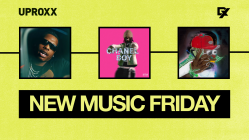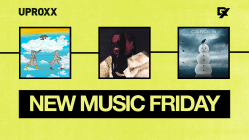January wasn’t a regular month. While people were chattering about how 2010 is going to be a better year, one musical heavyweight of the 1970s and 1980s decided to drop a new video. Gil Scott-Heron hasn’t been heard from for ages. In the mid 1970s, he was on top of his game as a musical genius battling racism with his microphone and uplifting the Black Power Revolution with his words. By 2010, Scott-Heron seems to be a battled man. In the middle of the month, I saw his video for “Me and the Devil,” a Robert Johnson cover about his musical relationship with the Devil. The video is a black and white night scene in New York following a Warriors-inspired group of skaters painted like skeletons and the entities they come across in their travels. I thought it looked dope and it pulled this audio/videophile into a compare and contrast contest with Nas‘ 2004 music video “Thief’s Theme.” Nice battle, eh? They look similar and both are influences to the Hip Hop community. With one exception, while the videos can be visually seen as being alike, the messages of the two men are vastly different.
As a photographer, I often watch music videos to freeze scenes because they would make a dope photograph. While looking at both music videos, it was cool to see how they were similar. Both videos document one night in New York through a distorted lens. New York is famous worldwide for being a background location for movies and television and for the sake of this website, it is the original birthplace of Hip Hop culture. Scott-Heron has often been sampled for beats (Kanye West and Common’s “My Way Home” and Mos Def’s “Mr. Nigga”) and Nas seems to be the kind of cat that listens to him on Saturday afternoons. The distorted view of New York in both videos allows the viewing audience to see a different, less clean and tourist-friendly city. Nas exposes the everyday thieves in neighborhoods while Heron’s video exposes the spirits that come out at night or a group of creepy, roaming death skaters. Both make obvious storytellers of the music artists themselves. Their performance scenes show both musicians unmasked in both forms (photographs of Heron through the decades replace him actually performing). At the end of “Thief’s Theme,” Nas finally dons his skeleton-printed ski mask to join the rest of his goons in a night to not act right. At the end of “Me and the Devil,” Scott-Heron’s song transforms the video to a poem he recites to about a vulture and its prey. Similarly portraying how sometimes the lines between good/evil and right/wrong can be very blurry in the middle of the night.
Last but not least, both videos are centered towards young kids between ages 18 to 25. There’s a stylish appeal about both videos in how the lighting is either natural or harshly bright. In particular, both videos are directed to the young kids that are at a stage where they can be easily influenced into hood life. Evil and wrong are then transformed as Nas becomes one of the thieves and Heron begins to recite his poem about death. Here’s where the contrast between the two videos begin.
Gil Scott-Heron has been a musical artist since the 1960s and has been down for the Revolution since. His poem about a scavenging, evil vulture solidifies his lyrical legacy that has influenced many emcees through the decades. Spoken word artists such as him and the Last Poets describe stories about hood life and Ghetto America in a clear, concise language that is reflective of the same communities they grew up in. For a while, Scott-Heron seemed to be a tragic soul man whose life was almost taken over by drugs. This album that’s about to come out, XL Recordings’ I’m New Here, is his first in quite some time. Longer than another heavyweight, Sade, whose album drops the same week. I’ve got to have both of them before the week is over. But, back to “Me and the Devil,” the poem he recites in the end is a haunting, Edgar Allen Poe-like tale of an evil vulture that can penetrate the ghetto at ease.
“Standing in the ruins of another black man’s life
or flying through the valley separating day and night,
‘I am death!’ cried the vulture,
‘For the people of the light.’
Charon brought his wrath from the sea that sails on souls
and saw the scavenger departing taking warm hearts to the cold.
He knew the ghetto was a haven
for the meanest creature ever known.
In a wilderness of heartbreak
and a desert of despair,
Evil’s clarion of justice shrieks a cry of naked terror.
Taking babies from their mamas
Leaving grief beyond compare.
So, if you see the vulture coming
flying circles in your mind;
Remember, there is no escaping
for he will follow close behind.
Only promise me a battle
for your soul
and mine.”
Ain’t no place like the hood if a character like Charon, aka Death’s homeboy, can see the hood and see its wreckage caused by another hand unnatural to the area. Enter the vulture. In Nas’s video, the vulture could be seen as every person that wore a mask to hide his or he face. However, there seems to be no ugly ending for these characters. They don’t meet face to face in a battle for his or her soul against a vulture. They aren’t plucked out of their mother’s arms as babies either. They had a choice to become a thief. For Scott-Heron, it seemed to be a choice he wished he could take back which he somberly shares at the very end of the video.
In the end, all I can share about these two videos is that while one seems to glorify a constant, ghetto state of becoming a thief in different forms, the other video shared tales of how and what happens when evil and wrong overcome your life. Robert Johnson was a Bluesman known for selling his soul to Devil to become a great (arguably thee greatest) Blues guitarist. He got his wish but upon death his soul had to be handed over to the Devil as it now and for eternity belonged to him (sounds like a music contract). That’s one hell of an autobiography to pull inspiration from when thinking about Gil Scott-Heron. I can understand why he would cover someone like Johnson at this point in the century and why his song was chosen for the first single. Everyday is battle between his soul and materialistic, decadent Earthly possessions. As he succumbed to them in his youth, similar to how Nas finally becomes a “thief” at the end of his video, he is now in a battle against them in his older age. This makes for the beginnings of a great Bluesman with an anticipated album dropping this week. Blues is often credited as a grandfather to Hip Hop and both are indigenous creations to American music. Scott-Heron has a rightful place in music history as someone whose lyrical creativity and musicianship are able to transcend decades even while overcoming something as strong as drug addiction. He’s better than the aging rockers of the ’60s, ’70s and ’80s. He’s Gil Scott-Heron and he’s forefathered Hip Hop since 1970, a Black American Gothic original.










nice write-up. been waiting for dx to do something on gil scoot-heron!
scott*
That’s a damn-good read, DX. I’m buying this album, and I had no idea that was a Robert Johnson record. I’m emailing this to all my folk.
Nice literary analysis, these types of blogs are the reasons why hip-hop is still alive and it’s good to see that there’s still out there that truly appreciates the culture.
Very dope and insightful article that draws correct parallels between Johnson/Heron/Nas. Most people are unaware that every modern form of music can be traced directly back to Robert Johnson. Hip-Hop in its pure form is the modern blues because it relates the averages man’s everyday struggles…It gives me the chills when I think about how Johnson sold his soul to the devil to make music. Looks like every clown-ass rapper cooning for a little fame and money on a major label is doing the same thing today.
Great docum u made re Gil, Nas, and Robert Johnson. Unique relationship with the three songs. Gil Scott Heron is a regular for me, (Winter in America) is my theme song. Did some research on Robert Johnson back in the day. THANKS…..for making us realize the relationship between the works of yesterday and today.
Great read.
I love the fact that every scene Gil Scott-Heron’s “Me and the Devil” was captured like a photograph.
The same can be said with Nas’ “Thief’s Theme”!
I think that Gil Scotts video was more visually interesting that Nas video. It’s funny how as a lot of people that weren’t used to these images would look at it as Devil Worship if they didn’t do the read up on the symbolism in it. Everyone is in a constant battle for their soul on a daily basis, wether its the decision to do/get off drugs, become a thief, or stay faithful vs cheating with another man/woman, etc.
good read writer…that thiefs theme video is one of my favorites its came up alot lately in conversation…herons video is excellent too thankls for hipping me to it.
good article.
we need more of this DX, and less BS editorials with typos everywhere. (my recent favorite was “Bob Merley”)
great read and analysis
This was a great read… I was start to look for new sites after the Conscious rap Blog…
My newest blog. Check it out and comment your thoughts. http://www.lifecypha.com/site/?p=199
Wow!!!! To whomever wrote this artice, I am very impressed and astonished at the knowledge I just read, I fkn love it. THANK YOU FOR THIS, I love sh*t thats deep and historic but this is just simply profound, mad respect to the person for spreading this articulate vision of his outlook on both of these songs and videos. THANK YOU.
Mr. Scott-Heron sounds like the dude that song one of “The Wire” theme songs.
song=sung
the dude you’re talkin about is legendary lyricist/musician Tom Waits and i recommend everyone to get into his music. and he wrote the song the Wire uses, but for some reason they decided to use a bunch of shitty covers and the original only one season
ha. i love it. its me all day.
the Scott-Heron video is awesome
the Scott-Heron video is awesome
I’m not sure about that!! All my hot and sincere friends on ======[PLUSFLIRT dot c O m]===== are talking about this!! BBW, it’s the place where hot models and sex y young men;and handsome folks with sensu al chick s meet and mingle! You may wanna check it out! LOL DFFFFFFFFFFFFFDD
HIPHOPDX please figure out a way to filter my bullshit out
HIPHOPDX please figure out a way to filter my bullshit out
Well written, props to G.S.H for re-surfacing! Show em how it’s done
Good read. I’ve always heard of Heron but this made me wanna check for dude. I was touched by that video/poem. Nas is one of the few artists whose music grabs me like that on an artistic, poetic level. I’ve followed his growth since Illmatic- best to ever do it in my eyes. The parallels are obvious- conflicted souls, trying to do good on one hand but influenced by the ills of the world. I think Nas’s take in that video was that everyone’s or most people are thief/hustler from the thugs, to the strippers, the bankers, the pastors and himself included and it’s the American way. The few that arent will soon become engulfed by that mentality- where everyone is out for their. While on the one hand, it may seem like he’s glorifying it, hes actually documenting it. Nas, has always been one of rap’s best documentarian on street and world issues. Fans of Nas always saw the glimpses of potential of him to be a leader as he is starting to become as shown with the boldness of his last three albums but he was always torn between sides- being a dreamer/idealist but pragmatic/practical in a system that favours the ‘thiefs’ and hustlers. I can relate to that conflict being a black male teacher that was raised in NY streets and is constantly fighting those tendencies.
that was a really good article! i was already thinking about that robert johnson cut…and then you dropped it in there!
dope.*****(5star)
Good ass write up! A bit preachy & presumptuous but still excellent post. I was introduced to two artists I have never heard of, Gil Scott Heron and Nas….LOL JK but GSH I’ve never heard of Robert Johnson I’ve heard but very little. Thanx for introducing me to both. I’ll be doin some research! The parallels between the videos are very apparent but most wouldn’t know about the latter to compare the 2 so again great post! I’m really diggin GSH would like to hear more before I buy an album though.
that nas video is dope
http://watchthishiphop.blogspot.com
Good shit. You enlightened me to some good ass tunes too.
Excellent Article!!!!! Big Ups to Carla Aaron Lopez. I’ve never even heard of Gil Scott Heron. After reading this article, I am aware of who he is and I will now look for his music. Thanks Carla!!
youre welcome.
great article, great videos.
now let me put you up on a video that is almost as good
Nas and AZ Sprite Commercial (1997)
http://www.youtube.com/watch?v=YrE2uHXBeq8
Tiiiiight lemme find out the intellect is coming back into the game , good write up
album’s dope. crazy short though.
Dope Article Ms Lopez! Keep doing your thing!
okay.
All this and Gil has history with Glasgow, his dad played football here in the 50s for Celtic and the now legendary Third Lanark and surely knows all about what we are about! Gil has inspired many artists like P.E. and been sampled by many but he
has a true claim to being one of the sons of Glasgow! Unbelieveable stuff and revolutionary!
http://www.212DIAMONDCITY.COM
212DIAMONDCITY
Our impressive selection of fine Men’s Diamond Rings includes white
gold rings, yellow gold rings, rose gold rings. Our rings are made in
10k gold, 14k gold, 18k gold, 21k gold, platinum, silver, sterling
silver and stainless steel. The mens diamond rings that we offer
feature brilliant round cut diamonds, princess cut diamonds, baguette
cut diamonds. We carry many different fancy color diamonds such as
canary yellow diamonds, blue diamonds, pink diamonds, red diamonds,
black diamonds, green diamonds. 212DIAMONDCITY
http://www.212DIAMONDCITY.COM
THE FINEST DIAMOND JEWELRY AT AFFORDABLE PRICES
http://www.212DIAMONDCITY.COM
212DIAMONDCITY
We carry a vast collection of mens rings which are both contemporary
and hip hop bling styles. Our collection of mens rings includes mens
wedding rings, mens wedding bands, mens engagement rings, mens
engagement bands, mens diamond rings, mens gold rings, men’s diamond
ring, mens silver ring, mens sterling silver rings ,Mens stainless
steel rings, Mens cubic zirconia (cz) rings, Mens pinky rings, mens
solitaire diamond rings, Multi-color diamond rings. 212DIAMONDCITY
http://www.212DIAMONDCITY.COM
I FIGHT MYSELF ABOUT RIGHT/WRONG EVERYDAY DEF APPRECIATE THE ARTICLE MYSPACE.COM/DAUNKNOWNPOET